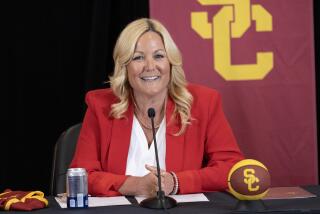Teams in Series Get Glory but No Gold
Schools whose teams reach the College World Series, which begins again Friday in Omaha, Neb., gain some glory for their baseball programs, but no financial windfall.
The NCAA, in fact, has lost money on the college baseball playoffs the last three years, according to Dennis Poppe, a director of NCAA championship events.
“But we stopped direct distribution of money based on how teams did in NCAA playoffs for all sports several years ago,” Poppe said.
That change came because of concerns over what became known as the “$250,000 free throw” in men’s basketball. Just one free throw, made or missed, could mean that much to a school, based on winning or losing an NCAA tournament game.
“It had created a situation that the NCAA decided wasn’t good,” Poppe said.
Now, all money from NCAA Division I championships goes into a general revenue pool, with a portion of that going back to the schools each year.
The amount of those distributions is based on several formulas. They involve the number of sports a school sponsors and the number of scholarships awarded, along with other considerations.
A large part of that revenue comes from the men’s basketball tournament.
The shares for individual conferences in basketball differs, based on the number of teams each sends to the NCAA playoffs as well as how far they advance during a six-year period.
Money from major football bowl game participation, however, is separate and distributed according to agreements between the bowls and the individual conferences or schools.
Increased transportation costs, primarily for team travel, have been the problem for the baseball playoffs, Poppe said.
“Our transportation costs have gone from something like $600,000 in 1995 to $1.02 million last year, mostly because of the increase in air fare costs,” Poppe said.
The baseball playoffs had a deficit of about $400,000 last year.
Poppe is hopeful the tournament will finish in the black this year, even though the bracket was expanded from 48 to 64 teams and eight super-regionals were added to the format.
TOP TEAMS SURVIVE
Seven of the eight nationally seeded teams reached the College World Series, which left Division I baseball committee chairman Dick Rockwell comfortable that his group did a good job of ranking the field.
The only seeded team that didn’t advance was Baylor, beaten on its home field by Oklahoma State.
“The new tournament format enabled us to keep the top teams separated, and I think we’ve got the eight best teams in Omaha this year,” Rockwell said.
Oklahoma State certainly is deserving after winning a tough regional at Wichita State, where the always-strong Shockers were the top-seeded team, and then taking two of three games at Baylor.
BUCKEYES HAVE SUPPORT
Ohio State is a good example of what strong financial support means to an athletic program.
There is the new Schottenstein Center, a $105-million arena that is the site for the Ohio State men’s and women’s basketball teams and the Buckeye hockey team.
Nearby is $4.7-million Davis Stadium, which was built for baseball three years ago and seats 4,450. It’s the main reason the Buckeyes were chosen to host the NCAA super-regional baseball playoffs last weekend instead of Cal State Fullerton.
Fullerton’s Titan Field could seat about 2,500 with the addition of more temporary bleachers.
Ohio State’s selection to host the super-regional underlined Fullerton’s need to further improve its stadium to be competitive.
A university advancement campaign is under way to raise $2.5 million. The money would be used for additional seating, locker rooms and offices at Titan Field. The goal is to increase seating capacity to around 3,800.
“We have a national program, and we need a national-quality place to play,” Titan Athletic Director John Easterbrook said.
TOUCHING ALL BASES
Louisiana State is absent from the College World Series for only the third time in the decade and the first time in four years. The Tigers won four championships in the 1990s. . . . Stanford pitchers Jason Young and Justin Wayne combined for 22 strikeouts in the two super-regional games against USC. “They shut us down,” USC catcher Eric Munson said. “We think we have a pretty good lineup, but good pitching will do that to good hitting.” Stanford plays Fullerton on Saturday.
More to Read
Go beyond the scoreboard
Get the latest on L.A.'s teams in the daily Sports Report newsletter.
You may occasionally receive promotional content from the Los Angeles Times.










